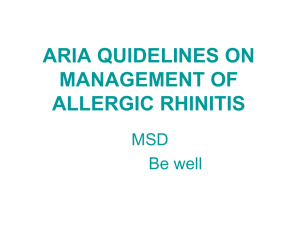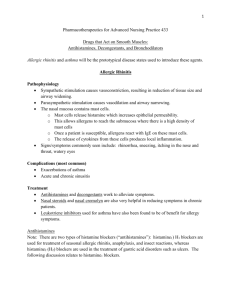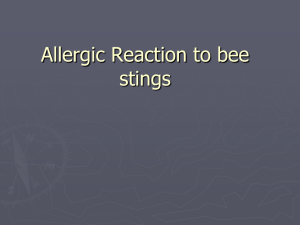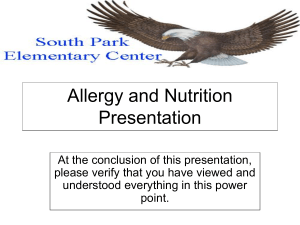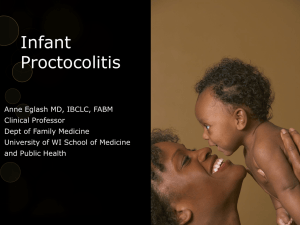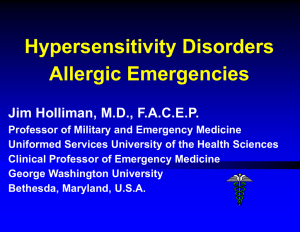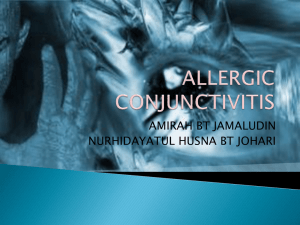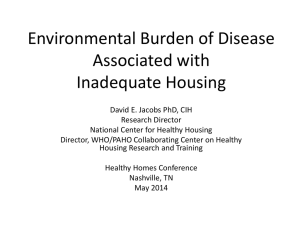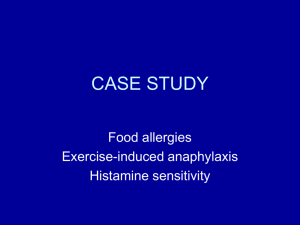Antiallergic agents
advertisement
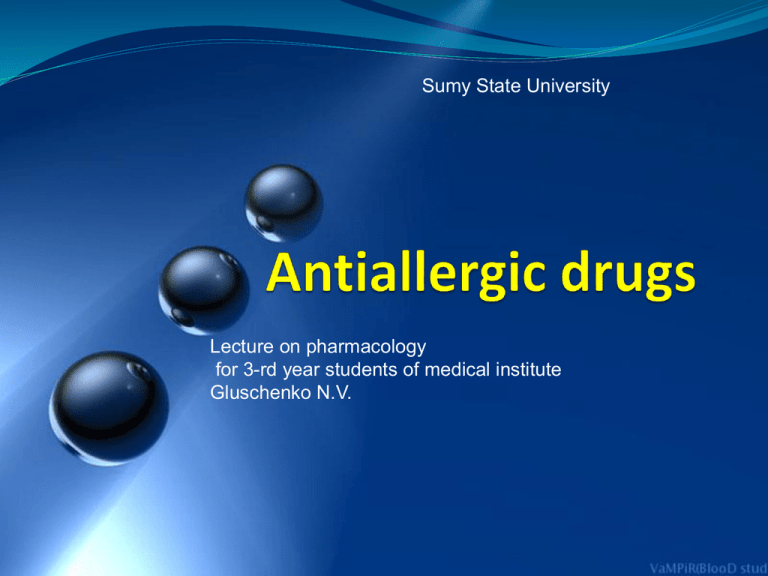
Sumy State University Lecture on pharmacology for 3-rd year students of medical institute Gluschenko N.V. Allergy represents a sensitivity to a specific substance, called an allergen, that is contacted through the skin, inhaled into the lungs or injected. The prevalence of allergic diseases and asthma is escalating. Approximately 30 to 40 percent of the world’s population suffers from allergic diseases. An estimated 300 million individuals worldwide have asthma, and this is likely to increase to 400 million by the year 2025.* Allergic rhinitis, a risk factor for asthma, affects 400 million people annually, and food allergies affect 200 to 250 million. The number of avoidable deaths from asthma occurring every year is estimated at 250,000.* *World Health Organization (WHO) Types of allergic reactions (according to Gell and Cumbs): I type reactions (anaphylactic) are a severe whole-body allergic reactions that occur within minutes of exposure, progresses rapidly and can lead to anaphylactic shock and death. Examples: -anaphylactic shock; -bronchial asthma. II type reactions (humoral cytotoxic immune reactions) Examples: -transfusion reactions; -Rh incompatibility Types of allergic reactions (according to Gell and Cumbs): III type reactions (autosensibilization) Examples: -arthus reactions; -serum sickness. IV type reactions Examples: -rejection of transplanted tissues; -contact dermatitis. Classification of allergic reactions in clinic: 1. reactions of immediate type (I, II, III after Cumbs) 2. reactions of delayed type (IV type after Cumbs) Allergy - Diagnosis Skin test Several allergens are introduced to the skin The test is positive if the skin shows a reaction General principles of prevention and treatment of allergic reactions: 1) Avoiding contact with the allergen. 2) Performing specific desensitization by repeated introduction of small doses of specific antigen. 3) Performing nonspecific desensitization through administration of drugs which depress immune reactions (immune depressants). 4) Using antiallergic drugs which are able to prevent releasing the mediators of allergic reactions through stabilization of mast sells’ membranes or to block receptors with which these mediators interact in tissues. 5) Symptomatic treatment of allergic reactions manifestations which have already developed. Directions of therapy of hypersensitivity reactions of immediate type 1) Antiallergic drugs : а) drugs which stabilize membranes of mast cells and basophiles and slow down releasing of mediators of hypersensitivity reactions; b) antihistamine drugs – block receptors with which histamine binds in the tissues. 2) Drugs which decrease damage of the tissues: Glucocorticosteroids. 3) Drugs of symptomatic treatment: Adrenalin; euphyllin. Antihistamine drugs R1 CH3 CH2-CH2-N R1 CH3 Structure of nucleus of Н1 histamine-receptors antagonists (H1 histamine-blockers) Allergy - Histamine Histamine: Endogenous bioactive amine: synthesized, stored and released in mast cells, which are abundant in the skin, GI, and the respiratory tract; basophils in the blood; neurons in the CNS and PNS. Physiological actions: Primary stimulant for gastric acid and pepsin secretion. (acid secretion is further enhanced by gastrin and vagal stimulation) Neurotransmitter (both in the CNS and peripheral sites). Pathophysiological actions: Mediator of immediate hypersensitivity reactions and acute inflammatory responses. Anaphylaxis. Duodenal ulcer. Allergy - Histamine Receptors: part of the super family of G-protein coupled receptors H1-Receptors: Gq coupled to Phospholipase C. CNS, smooth muscle cells of airways, GI tract, cardiovascular system, endothelial cells and lymphocytes => Vasodilation, bronchoconstriction, seperation of endothelial cells, pain and itching, allergic rhinitis, motion sickness. H2-Receptors: Gs coupled to Adenylyl Cyclase. Parietal cells of stomach; vascular smooth muscle cells => mediate histamine induced gastricacid secretion; vasodilation. Allergy - Histamine H3-Receptors: Gi/o coupled to AC, also to N-type voltage gated Ca channels and reduce Ca influx. CNS => Presynaptic, feedback inhibition of histamine synthesis and release; also controls release of other neurotransmitters. H4-Receptors: coupled to Gi/o in mast cells, can trigger calcium mobilization. found primarily in bone marrow and immune cells => mast cell chemotaxis. Allergy - Histamine Effects Actions of Histamine: Vascular: H1 - vasodilation mediated by NO and PGs (via endothelial cells); H2 - vasodilation mediated by cAMP (vascular smooth muscle cells); H1 - coronary vasoconstriction; H1 - increased permeability of post capillary venules => edema. Heart: H1 - decreased AV conduction; H2 - increased chronotropy; H2 - increased inotropy. Lung: H1 – bronchoconstriction; H1 - increased mucus viscosity; H1 - stimulation of vagal sensory nerve endings: cough and bronchospasm. Gastrointestinal System: H2 - acid, fluid and pepsin secretion; H1 - increased intestinal motility and secretions. Cutaneous Nerve Endings: H1 - pain and itching. Symptoms range from mild allergic symptoms to anaphylactic shock: Mild/cutaneous: erythema, urticaria, and/or itching. Moderate: skin reactions, tachycardia, dysrhythmias, moderate hypotension, mild respiratory distress. Severe/anaphylactic: severe hypotension, ventricular fibrillations, cardiac arrest, bronchospasm, respiratory arrest. Allergy - Drugs Targeting Histamine H1 Receptor Antagonists – H1-histamine blockers. They are antiallergic drugs. H2 Receptor Antagonists – H2-histamine blockers. This drugs decreas secretion of HCl, use for the treatment of stomach ulcer. Mast Cell Stabilizers Mechanism of action of “Antihistamines” drugs block histamine H1-receptors, reducing or eliminating the effects of histamine: spasm of the bronchial tubes, intestines, uterus, lower blood pressure, increased vascular permeability, itching, swelling, redness. block histamine receptors available. Drugs not displace molecules mediator, are connected to receptors. This is because the affinity of histamine for H1 receptors significantly higher. H1-Antagonists (“Antihistamines” drugs) First generation drugs (Sedating): Ethylenediamines: 1st antihistamines => obsolete Ethanolamines: Diphenhydramine (Dimedrol, Benadryl) Doxylamine Clemastine Alkylamines: Chlorpheniramine (Suprasytine) Piperazines: Diprasine, Meclizine, Hydroxyzine Ather drugs: Fenkarol Diasoline Pharmacological characterization of antihistamine drugs of the first generation Peripheral anti-muscarinic effects: (also block Mreceptors). Cased by dry mouth, blurred vision, constipation, urinary retention. Antyserotonin activity (increase of appetite and increase of body weight). Potentiate CNS depressants (opioids, sedatives, general anasthetics, alcochol). There are an injectable forms of release so used for the treatment of acute allergic conditions. Pharmacological characterization of antihistamine drugs of the first generation Effect occurs within 15-20 min. after administration. Penetrate through blood/brain barrier (lipophilicity) and block H1-receptors of CNS, and as a result, cause sedation and reduce coordination of attention (contraindicated in occupations related to concentration). Have short duration of action, as prescribed 3-4 times per day. Prolonged use develops tachyphylaxis (reduced therapeutic efficiency). Therefore is necessary to replace one drug of another drug from this group every 7-10 days. Indications for use of antihistamine drugs of the first generation 1. 2. 3. 4. 5. 6. Anaphylactic reactions. Antiallergy (allergic rhinitis, allergic dermatoses, contact dermatitis). Sedative/sleep aid. Prevention of motion sickness. Premedication. For potention of CNS depressants (opioids and nonopoid analgesics, sedatives drugs). Side effects of Н1-histamine receptors blockers of 1st generation 1) Depression of CNS (disorders of coordination, increased tiredness, dizziness, diplopia, tremor, euphoria, nervousness, insomnia). 2) Disturbance of GI functioning : increase of appetite, nausea, vomiting, pain in epigastria, constipation or diarrhea. 3) As a result of M-cholinoblocking activity – dryness of mucous membranes, eye disorders - blurred vision, impotence, ischuria, tachycardia, headache, psychosis. 4) In case of repeated administration – tachyphylaxis. H1-Antagonists drugs of the second generetion (non-sedating) 1. Terfenadine (Lamisil) 2. Astemisole (Hismanal) 3. Loratadine (Klaritin) 4. Akrivastine 5. Cetirisine (Zirtec) 6. Levakarbastine 7. Azelastine Pharmacological characterization of antihistamine drugs of the second generation 1. High specificity and affinity to Н1-receptors. 2. Non penetrable through blood/brain barrier in therapeutic doses (have not sedative action). 3. Absence of blockade of other types of receptors ( M-cholino-, Serotonin-receptors). 4. That way don’t increase of appetite and body weight, don’t cased by dry mouth, blurred vision, constipation, urinary retention. Pharmacological characterization of antihistamine drugs of the second generation 1. Have long duration of action (over 24 hours). Prescribe 1 time per day. 2. Absence of tachyphylaxis. Can be administered for a long time (up to 1 year). 3. After withdrawal of the drugs – have efficiency during the 1 week. Side effects of Н1-histamine receptors blockers of the second generation Drugs are metabolized by CYP- 450 enzymes (Terfenadine and Astemisole) . In patients with liver diseases, in case of higher daily doses, with administration of drugs that also are metabolized by CYP- 450 enzymes can cause ventricular tachycardia. Examples of such drugs: Macrolides (erythromycin, clarithromycin) Antifungal drugs (intraconazole, ketaconazole). Drugs are contraindicated during pregnancy and lactation. Pharmacological characterization of antihistamine drugs of the third generation Drugs are pharmacologically active metabolites of antihistamine drugs of the second generation. Have been created to eliminate cardio-toxicity and enhance the effect. H1-Antagonists drugs of the third generetion (non-sedating) Active metabolite of Terfenadine – is Fexofenadine (Allegra, Telfast, Fastofen, Tilfur, Vifas, Telfexo, Allerfexo) H1-Antagonists drugs of the third generetion (non-sedating) Active metabolite of Loratadine – is Dezloratadine NeoClarityn, Claramax, Clarinex, Larinex, Aerius, Dazit, Azomyr, Deselex. H1-Antagonists drugs of the third generetion (non-sedating) Active metabolite of Cetirizine – is Levocetirizine (Xyzal) Pharmacological characterization of antihistamine drugs of the third generation Have 3 mechanisms of action: 1. antihistaminic — blocking of Н1-histamine receptors; 2. antiallergic — suppression of leukotriene and proinflammatory cytokine production; 3. anti-inflammatory effect — decrease in production of granulocytic macrophage factor. Action begin in 15–30 minutes after the intake and lasts more than 24 hours. Prescribe 1 time/day. Pharmacological characterization of antihistamine drugs of the third generation They are not linked to cytochrome Р450 system, and thus it does not overload hepatocytes in relation to detoxification function. Have not cardiotoxic action. This medicinal drugs are excreted by liver and kidneys in unchanged state. Owing to such peculiarities, can be taken concomitantly with other preparations. Antibiotics Antimycotics Antidepressants H2-histamine receptor blockers Ethanol Indications for use of H1-Antagonists drugs of 2- and 3- generetions allergic rhinitis and pollinosis; allergic conjunctivitis, pharyngitis; acute urticaria; atopic dermatitis; bronchial asthma of allergic etiology; medicamentous allergy, which is manifested by skin symptomatic — there may develop Quincke's edema, Lyell's syndrome, and Stevens-Johnson syndrome. Contrindications for use of H1-antagonists drugs of 2- and 3 generetions Should not be used in cases of: Pregnancy. Lactation. Hypersensitivity to any components of the preparation. The preparation should be used with caution in: Sever liver failure. Young age prior to 2 years. Mast Cell Stabilizers Sodium Cromoglycate (Intal, Nasalcrom) Nedocromil (Tilade) Mechanism of action They block a calcium channel essential for mast cell degranulation, stabilizing the cell and thereby preventing the release of histamine and related mediators. One suspected pharmacodynamic mechanism is the blocking of IgE-regulated calcium channels. Without intracellular calcium, the histamine vesicles cannot fuse to the cell membrane and degranulate. Indications for use: Treatment of bronchial asthma ( As inhalers to prevent asthma attack). Allergic rhinitis (as nasal sprays). Allergic conjunctivitis (as eye drops). Drugs only help prevent them - and they work best if and only if you use their regularly, and if you start using it well before (like 2-4 weeks before) the beginning of the season for your particular allergens. Allergy - Leukotrienes Leukotrienes: Generated by 5- Lipoxygenase: Converts AA into 5HPETE, which in turn is converted into – LTB4: potent mediator of inflammation and – Cysteinyl-LTs (LTC4, LTD4, LTE4 = SRS-A): mediate asthmatic responses Physiological actions: LTB4: Cys-LTs: Mediated by specific LTB4 Mediated by shared receptor receptor. Adherence, chemotaxis and activation of macrophages. Stimulates cytokine and chemokine production. Present in inflammatory exsudates (RA, ulcerative colititis, psoriasis). for LTC4, LTD4 and LTE4. Contraction of bronchial muscles (longer lasting than histamine). Peripheral vasodilation, coronary vasoconstriction. Found in sputum of chronic bronchitis, asthmatic lung; lavage of allergic rhinitis. Classification 1. Leukotriene Esterase Inhibitors: (5-Lipoxygenase inhibitor) Zileuton (Zyflo) 2. Cys-LTs-R antagonists: Montelukast (Singulair ) Zafirlukast (Accolate) Zileuton Mechanism of action: specific inhibitor of 5-lipoxygenase and thus inhibits leukotrienes (LTB4, LTC4, LTD4, and LTE4) formation. Pharmacological effects: contribute to inflammation, edema, mucus secretion, and bronchoconstriction in the airways of asthmatic patients. Montelukast and Zafirlukast Pharmacological effects: Mechanism of action blocker Cys-LTs-R and prevent effects of cysteinyl -leukotrienes (LTC4, LTD4, LTE4) Decrease airway edema, smooth muscle contraction, and altered cellular activity associated with the inflammatory process. In allergic rhinitis, decrease symptoms of nasal obstruction. Cys-LTs-R antagonists: Indications for use: for the prophylaxis and chronic treatment of moderate and severe bronchial asthma in adults and children 12 years of age and older; for the relief of symptoms of allergic rhinitis (seasonal allergic rhinitis in adults and pediatric patients 12 years of age and older); aspirin-induced asthma. Side effects Erythromycin reduces the absorption of zafirlukast, potentially reducing the effects of zafirlukast. Hepatotoxicity. Indicated in age only 12 and over. Contraindicated during pregnancy and breastfeeding. Expensive ($ 273 per month for zileuton). Ant allergic and anti-inflammatory drugs Important agents Injactable Inhalation Betamethasone Beclamethasone Prednisolone Flunisalide Hydrocortisone Budesonide Dexamethasone Methylprednisolone Triamcinolone Important agents Oral Topical Betamethasone Betamethasone Prednisolone Flucinolone Methylprednisolone Clobetasol Fludricortisone Mometasone Mechanism of antiallergic action: Suppress all types of hypersensitivity and allergic phenomenon. At high dose: Interfere with all steps of immunological response. Causes greater suppression of Cell-mediated immunity (graft rejection and delayed hypersensitivity). Transplant rejection: antigen expression from grafted tissues, delay revascularization, sensitisation of T- lymphocytes etc. Indications for use Autoimmune hemolytic anemia. Idiopathic thrombocytopenic purpura. Organ transplant combine with other immunosuppressant's. In anaphylaxis, angioneurotic aedema, serum sickness. Seasonal allergies, bee sting, drug allergies. Bronchial asthma In severe asthma attack – Hydrocortisone, Prednisolone, Methylprednisoline. Acute attack – inhalated Beclamethasone Flunisalide Budesonide Indications for use Allergic ocular diseases. Allergic skin diseases (eczema). Thank you!!!

